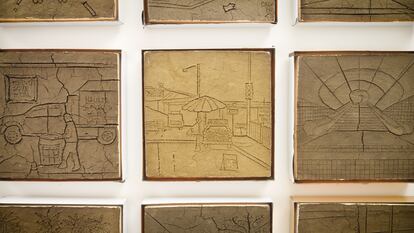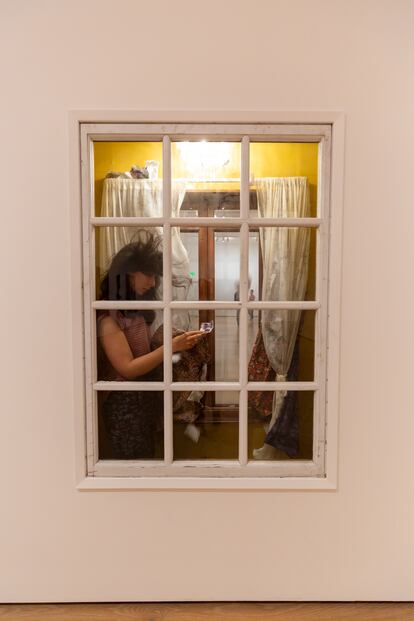‘Made in L.A.’: All the faces of an undefinable city in a single exhibition
The Hammer Museum’s ‘Made in L.A.: Acts of Living’ showcases pieces by 39 artists who work in the city, focusing on shared themes like identity, family and community


For the exhibition Made in L.A.: Acts of Living, Guatemalan artist Jackie Amézquita made a map of the city where she arrived at the age of 17. But the map is not a piece of paper, and there are no avenues or streets on it. Instead, she has decided to portray the massiveness of the city on 144 slabs made from cornmeal, limestone and earth. Each one represents a Los Angeles neighborhood. The pieces have drawings of urban scenes, including emblematic buildings, barbecues in public parks and images of the omnipresent traffic. The Land That Feeds Us (2023) makes up a huge grid that has been on display for the past few days at the Hammer Museum’s biennial dedicated to artists who live and work in Los Angeles.
Together, the exhibit’s curators, Diana Nawi and Pablo Jose Ramirez, visited nearly 200 studios to select the 39 artists whose work is presented in Made in L.A. Their first list had 51 names, but space limitations forced them to further narrow it down. The result is one of the country’s most eagerly awaited fall exhibitions. The group of artists reflects the creative explosion underway in Los Angeles; while it has always been one the country’s creative centers, it is experiencing a renewed boom. One example of that is the fact that international galleries have traveled here in recent years to witness this creative activity, which some compare to New York in the 1970s.
“Non-Western art is gaining a lot of ground,” says Pablo José Ramírez, 40. Previously, the Guatemalan-born curator was in charge of contemporary indigenous art at the Tate Modern. He crossed the Atlantic to join the Hammer and prepare this exhibition with Nawi, an art historian who has lived in Los Angeles for several years. The result of their work, which people can see at the museum until December 31, is a face of the forces that coexist in a city that resists having a single version and is composed of 80 small cities. “Eighty percent are non-white artists. There are more indigenous and Latino artists not because we set out to do so, but because the most interesting stuff is being done by these people,” the curator adds.

Maria Maea’s work reflects the curator’s statement. The 35-year-old Long Beach artist of Mexican and Samoan descent uses the palm, an endemic plant with a long history of migration, for her pop-up works. In one of her recent shows, Maea attended once a week to weave the dried plant and give an ethereal body to a mask created based on a family member’s face. Thus appears a cyclist who appears to pedal a long-handled lowrider bicycle in The Jade (2021), made from onion plant debris, orange bunches and sunflowers. In another piece, Untitled (Nephew, 2020), Maea creates a figure from garden debris, such as jasmine plants, proteas, and milkweed, representing a commentary on family and community.
The works are divided into five different thematic groups. The city provides common ground for shared concerns, such as climate change, transnational identity, street violence, body autonomy, and family. These works offer fresh looks at classic Angeleno themes, such as the multicolored sunsets over the Pacific, the influence of Hollywood popular culture, and some renditions of urban art such as graffiti and store signs.
The exhibit space includes some of American society’s current discussions. Page Person has turned her experience into a large-scale work. After coming out as trans in 2017, the artist claims to have been marginalized in art spaces. So, that year she began performing in drag shows, where she aimed to communicate the simple message, “I AM A PERSON.” The Hammer displays the dresses Person used in those show, as well as some of the oil paintings she began working on in 2020, loaded with lots of paint and glitter.
Christopher Suarez, who is originally from South Los Angeles, has created his neighborhood in ceramics. He turned businesses, churches, residential buildings and even Chittick Field, an athletic field in Long Beach, the community where he grew up, into miniatures. He uses the same material to shape the trucks and cars that travel the streets. His work is a way of paying tribute to the actual businesses that Mexican immigrants opened in the area, including his father and maternal grandfather, to put down roots in their new country.
“A large majority work with materials that are not neutral; they have a specific cultural history,” says Ramirez. “And many work with diasporic materials, sensibilities and histories. There is a recognition that art does not come from nothing, contrary to some modernist variants. It has a history, a family, a community and a context, a set of relationships,” the curator says.

Such relationships are evident to viewers in works such as Inertia-Warn the Animals (2023)., on the one hand, Ishi Glinsky’s monumental sculpture is a nod to popular culture; on the other, it is a recognition of indigenous peoples. The mask popularized by Wes Craven in the modern slasher horror classic, Scream, is retouched with contributions from eleven local artists, each belonging to a different native tribe. The work features goatskin, wool, clay, willow remnants, yarn, shells and bear grass, among other materials.
But perhaps it is one of the simplest works that evokes the most feelings. Two window frames, connecting two galleries, are enough to nostalgically carry the weight of the diaspora in a city open to immigration. With her installations, Iranian Roksana Pirouzmand shows the clash between body and memory. For the performance Between Two Windows (2023), the artist enters the narrow space, shaken by a powerful air current. In the tiny space, in full view of all visitors, Pirouzmand attempts to capture family photographs and letters. The small, claustrophobic window captures the subjects of many of the 39 exhibiting artists.
Sign up for our weekly newsletter to get more English-language news coverage from EL PAÍS USA Edition
Tu suscripción se está usando en otro dispositivo
¿Quieres añadir otro usuario a tu suscripción?
Si continúas leyendo en este dispositivo, no se podrá leer en el otro.
FlechaTu suscripción se está usando en otro dispositivo y solo puedes acceder a EL PAÍS desde un dispositivo a la vez.
Si quieres compartir tu cuenta, cambia tu suscripción a la modalidad Premium, así podrás añadir otro usuario. Cada uno accederá con su propia cuenta de email, lo que os permitirá personalizar vuestra experiencia en EL PAÍS.
¿Tienes una suscripción de empresa? Accede aquí para contratar más cuentas.
En el caso de no saber quién está usando tu cuenta, te recomendamos cambiar tu contraseña aquí.
Si decides continuar compartiendo tu cuenta, este mensaje se mostrará en tu dispositivo y en el de la otra persona que está usando tu cuenta de forma indefinida, afectando a tu experiencia de lectura. Puedes consultar aquí los términos y condiciones de la suscripción digital.
More information
Archived In
Últimas noticias
Most viewed
- Sinaloa Cartel war is taking its toll on Los Chapitos
- Oona Chaplin: ‘I told James Cameron that I was living in a treehouse and starting a permaculture project with a friend’
- Reinhard Genzel, Nobel laureate in physics: ‘One-minute videos will never give you the truth’
- Why the price of coffee has skyrocketed: from Brazilian plantations to specialty coffee houses
- Silver prices are going crazy: This is what’s fueling the rally










































